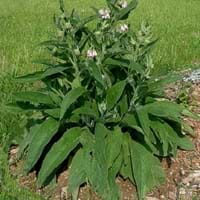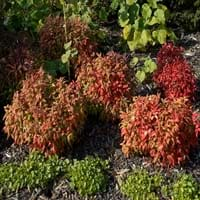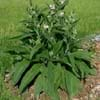Life Span
Perennial
Perennial
Type
Broadleaf Evergreen
Broadleaf Evergreen
Origin
Europe, Russia
China, Japan
Types
Symphytum officinale (common comfrey), Symphytum asperum (rough comfrey)
Heavenly Bamboo, Nandina 'Colerno'
Dwarf Nandina 'Compacta'
Dwarf Nandina 'Filamentosa'
Heavenly Bamboo, Nandina 'Harbor Belle'
Heavenly Bamboo, Nandina 'Moon Bay'
Habitat
Cold Regions, stream banks
low mountains, Mountain tops, Mountains, Valley
USDA Hardiness Zone
6-11
6-11
Habit
Upright/Erect
Clump-Forming
Flower Color
White, Light Pink
-
Flower Color Modifier
Bicolor
Bicolor
Leaf Color in Spring
Red, Green, Copper
Green, Purple, Copper
Leaf Color in Summer
Green, Blue Green
Green, Purple
Leaf Color in Fall
Green, Blue Green
Green, Purple
Leaf Color in Winter
Red, Dark Green, Burgundy, Bronze
Red, Green, Purple
Leaf Shape
Oval
Acuminate
Plant Season
Spring, Summer, Fall, Winter
Spring, Summer, Fall, Winter
Sunlight
Full Sun, Partial Sun, Partial shade
Full Sun, Partial Sun, Partial shade, Full Shade
Growth Rate
Medium
Medium
Type of Soil
Loam, Sand
Loam, Sand
The pH of Soil
Acidic, Neutral
Acidic, Neutral, Alkaline
Soil Drainage
Well drained
Well drained
Bloom Time
Late Spring, Early Summer, Summer
-
Where to Plant?
Container, Ground
Ground
How to Plant?
Root Division, Transplanting
Seedlings
Plant Maintenance
Low
Medium
Watering Requirements
Allow to dry out slightly between watering, Water daily during growing season
Do not water frequently, Needs less watering
In Summer
Lots of watering
Lots of watering
In Spring
Moderate
Moderate
In Winter
Average Water
Average Water
Soil pH
Acidic, Neutral
Acidic, Neutral, Alkaline
Soil Type
Loam, Sand
Loam, Sand
Soil Drainage Capacity
Well drained
Well drained
Sun Exposure
Full Sun, Partial Sun, Partial shade
Full Sun, Partial Sun, Partial shade, Full Shade
Pruning
Cut or pinch the stems, Remove dead leaves
Remove damaged leaves, Remove dead branches, Remove dead leaves
Fertilizers
14-14-14 Fertilizer, All-Purpose Liquid Fertilizer, can go long without fertilizers
All-Purpose Liquid Fertilizer
Pests and Diseases
Aphids, Stem spot
Red blotch
Plant Tolerance
Shallow soil, Sun
Drought
Flower Petal Number
Single
-
Foliage Texture
Medium
Fine
Foliage Sheen
Glossy
Glossy
Attracts
Ants, Butterflies, pollinators
Mealybugs, Whiteflies
Allergy
Antibacterial, Peripheral Edema
-
Aesthetic Uses
Cottage Garden, Showy Purposes
Bonsai, Borders
Beauty Benefits
Acne, Beautiful Skin, Reduce Bruises, Remove blemishes
-
Environmental Uses
Air purification, Fixes Nitrogen
Air purification
Medicinal Uses
Asthma, Diarrhea, Obesity, Osteoarthritis
Antirheumatic, Antitussive, Astringent
Part of Plant Used
Leaves, Twigs
Fruits, Leaves
Other Uses
Used for its medicinal properties
Used for making informal hedge
Used As Indoor Plant
No
No
Used As Outdoor Plant
Yes
Yes
Garden Design
Container, Feature Plant, Foundation, Groundcover, Hedges, Mixed Border, Tropical
Container, Edging, Foundation, Groundcover, Hedges, Mixed Border, Topiary, Bonsai, Espalier
Botanical Name
Symphytum asperum
NANDINA domestica 'Nana Purpurea'
Common Name
Comfrey,Black Root, Blackwort, Bruisewort
heavenly bamboo
sacred bamboo
nandina
In Hindi
Blackwort
Dwarf Nandina
In German
Blackwort
Dwarf Nandina
In French
Blackwort
Nandina Dwarf
In Spanish
Blackwort
Nandina enana
In Greek
Blackwort
Dwarf Nandina
In Portuguese
Blackwort
Nandina do anão
In Polish
Blackwort
Dwarf Nandina
In Latin
Blackwort
Dwarf Nandina
Phylum
Magnoliophyta
Tracheophyta
Class
Magnoliopsida
Magnoliopsida
Order
Lamiales
Ranunculales
Family
Boraginaceae
Berberidaceae
Clade
Angiosperms, Eudicots, Rosids
Angiosperms, Eudicots
Subfamily
Boraginoideae
-
Importance of Comfrey and Dwarf Nandina
Want to have the most appropriate plant for your garden? You might want to know the importance of Comfrey and Dwarf Nandina. Basically, these two plants vary in many aspects. Compare Comfrey and Dwarf Nandina as they differ in many characteristics such as their life, care, benefits, facts, etc. Every gardener must at least have the slightest clue about the plants he wants to plant in his garden. Compare their benefits, which differ in many ways like facts and uses. The medicinal use of Comfrey is Asthma, Diarrhea, Obesity and Osteoarthritis whereas of Dwarf Nandina is Antirheumatic, Antitussive and Astringent. Comfrey has beauty benefits as follows: Acne, Beautiful Skin, Reduce Bruises and Remove blemishes while Dwarf Nandina has beauty benefits as follows: Acne, Beautiful Skin, Reduce Bruises and Remove blemishes.
Compare Facts of Comfrey vs Dwarf Nandina
How to choose the best garden plant for your garden depending upon its facts? Here garden plant comparison will help you to solve this query. Compare the facts of Comfrey vs Dwarf Nandina and know which one to choose. As garden plants have benefits and other uses, allergy is also a major drawback of plants for some people. Allergic reactions of Comfrey are Antibacterial and Peripheral Edema whereas of Dwarf Nandina have respectively. Having a fruit bearing plant in your garden can be a plus point of your garden. Comfrey has showy fruits and Dwarf Nandina has no showy fruits. Also Comfrey is not flowering and Dwarf Nandina is not flowering . You can compare Comfrey and Dwarf Nandina facts and facts of other plants too.





